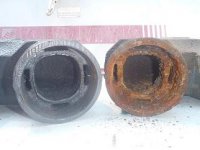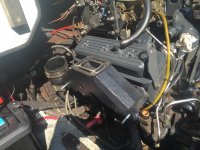Hi. I'm fairly new to the forum. I've done lots of car work in the past and some work on my own boats. I bought my current boat new in 2016. The boat is a 2015 Stingray 225 LR with a 350 mag mpi and a Bravo 3. I mainly boat in brackish water. The boat currently has 275 hours on it. I'd like to say I flush religiously after every trip.....but I flush about 90% of the time. The other 10% of the time I'm lazy and don't flush until a couple days or a week later.....I know....not the best approach.
The boat typically ran around 150-160 degrees (as read by the gauge on the dash) until last season when the temp seemed to slowly creep up to about 170 or so if I was cruising at 40pmh or more. Typically I cruise around 28 mph.
When I winterize, I heat the engine up on a hose, drain the water (take out all the blue drain plugs and the block drains), reconnect everything, then run 5 gallons of RV antifreeze through the engine using a 5 gallon bucket connected to ear muffs. EXCEPT for this past winter. This past winter I just pulled the water lines off both sides of the block then took out 3 blue plastic plugs. Didn't realize there were 2 more in the seawater pump....duh....oh well....the pump appears to have survived.
I took the boat out for the first outing of the season last weekend. I noticed the temp rise up to 200 on the gauge. I immediately brought it back to idle, idled back to the dock, and took the boat home.
The thermostat and seawater pump impeller were original, so I replaced them. The impeller is a mercruiser part and the thermostat is a Sierra part. Went for a test ride today and the temperature was still going up to 200 then cooling back down to 170. Knowing that my cooling 'innards' were just replaced, I kept cruising around 27mph (~2500-2700 rpm) for about 10 minutes. The temperature continued to fluctuate between 170-200 at the gauge. This fluctuation is the same whether I'm at idle or cruising.
I have the mercury vessel view module / app on my phone. I connected to it and saw the temperature fluctuated between 150-160 on the dot (160 degree thermostat) as read by whatever sensor vesselview reads from. I touched the top of my catalytic converters and I could keep my palm on them for about 20 seconds then it was slightly uncomfortable. This is hotter then they were last year, but not scalding.
I started feeling hoses at the thermostat housing. 3 hoses were cool. The large hose that goes to the water circulator pump was warm / hot. I also felt the oil filter and it was hot. Couldn't keep my hand on it for more than a few seconds.
Now finally my question: what the heck is going on? The temperature did not fluctuate like that until this year. What is causing the temperature fluctuations? Why is the large cooling hose feeding the circulator (aka water pump) hot at the thermostat housing while the other 3 are cool? I’m not sure if this is expected or. It. Why are my manifolds / catalytic converters hot to the touch when they weren't before?
All these temperature readings seem like they are still acceptable (except for the fact that my gauge in the dash is showing temps up around 200) but these represent a change from previous years.......and I’m not comfortable taking the boat out until I’m convinced the cooling system is operating properly.
One more piece of information: This is a diagram of my thermostat housing:
https://www.hardin-marine.com/s-2656...d-cooling.aspx
The hose connected to "1" in the diagram is the one getting warm/hot. Not sure if that hose is supposed to get hot or not. Any advice to help me understand the cooling flow of my engine would be appreciated. I tried to find a cooling flow diagram that showed me which hoses were cool water vs which ones were hot, but I had no luck for my particular engine / year.
Any help would be appreciated.
Feel free to ask me dumb questions because I'm not above making dumb mistakes

The boat typically ran around 150-160 degrees (as read by the gauge on the dash) until last season when the temp seemed to slowly creep up to about 170 or so if I was cruising at 40pmh or more. Typically I cruise around 28 mph.
When I winterize, I heat the engine up on a hose, drain the water (take out all the blue drain plugs and the block drains), reconnect everything, then run 5 gallons of RV antifreeze through the engine using a 5 gallon bucket connected to ear muffs. EXCEPT for this past winter. This past winter I just pulled the water lines off both sides of the block then took out 3 blue plastic plugs. Didn't realize there were 2 more in the seawater pump....duh....oh well....the pump appears to have survived.
I took the boat out for the first outing of the season last weekend. I noticed the temp rise up to 200 on the gauge. I immediately brought it back to idle, idled back to the dock, and took the boat home.
The thermostat and seawater pump impeller were original, so I replaced them. The impeller is a mercruiser part and the thermostat is a Sierra part. Went for a test ride today and the temperature was still going up to 200 then cooling back down to 170. Knowing that my cooling 'innards' were just replaced, I kept cruising around 27mph (~2500-2700 rpm) for about 10 minutes. The temperature continued to fluctuate between 170-200 at the gauge. This fluctuation is the same whether I'm at idle or cruising.
I have the mercury vessel view module / app on my phone. I connected to it and saw the temperature fluctuated between 150-160 on the dot (160 degree thermostat) as read by whatever sensor vesselview reads from. I touched the top of my catalytic converters and I could keep my palm on them for about 20 seconds then it was slightly uncomfortable. This is hotter then they were last year, but not scalding.
I started feeling hoses at the thermostat housing. 3 hoses were cool. The large hose that goes to the water circulator pump was warm / hot. I also felt the oil filter and it was hot. Couldn't keep my hand on it for more than a few seconds.
Now finally my question: what the heck is going on? The temperature did not fluctuate like that until this year. What is causing the temperature fluctuations? Why is the large cooling hose feeding the circulator (aka water pump) hot at the thermostat housing while the other 3 are cool? I’m not sure if this is expected or. It. Why are my manifolds / catalytic converters hot to the touch when they weren't before?
All these temperature readings seem like they are still acceptable (except for the fact that my gauge in the dash is showing temps up around 200) but these represent a change from previous years.......and I’m not comfortable taking the boat out until I’m convinced the cooling system is operating properly.
One more piece of information: This is a diagram of my thermostat housing:
https://www.hardin-marine.com/s-2656...d-cooling.aspx
The hose connected to "1" in the diagram is the one getting warm/hot. Not sure if that hose is supposed to get hot or not. Any advice to help me understand the cooling flow of my engine would be appreciated. I tried to find a cooling flow diagram that showed me which hoses were cool water vs which ones were hot, but I had no luck for my particular engine / year.
Any help would be appreciated.
Feel free to ask me dumb questions because I'm not above making dumb mistakes























